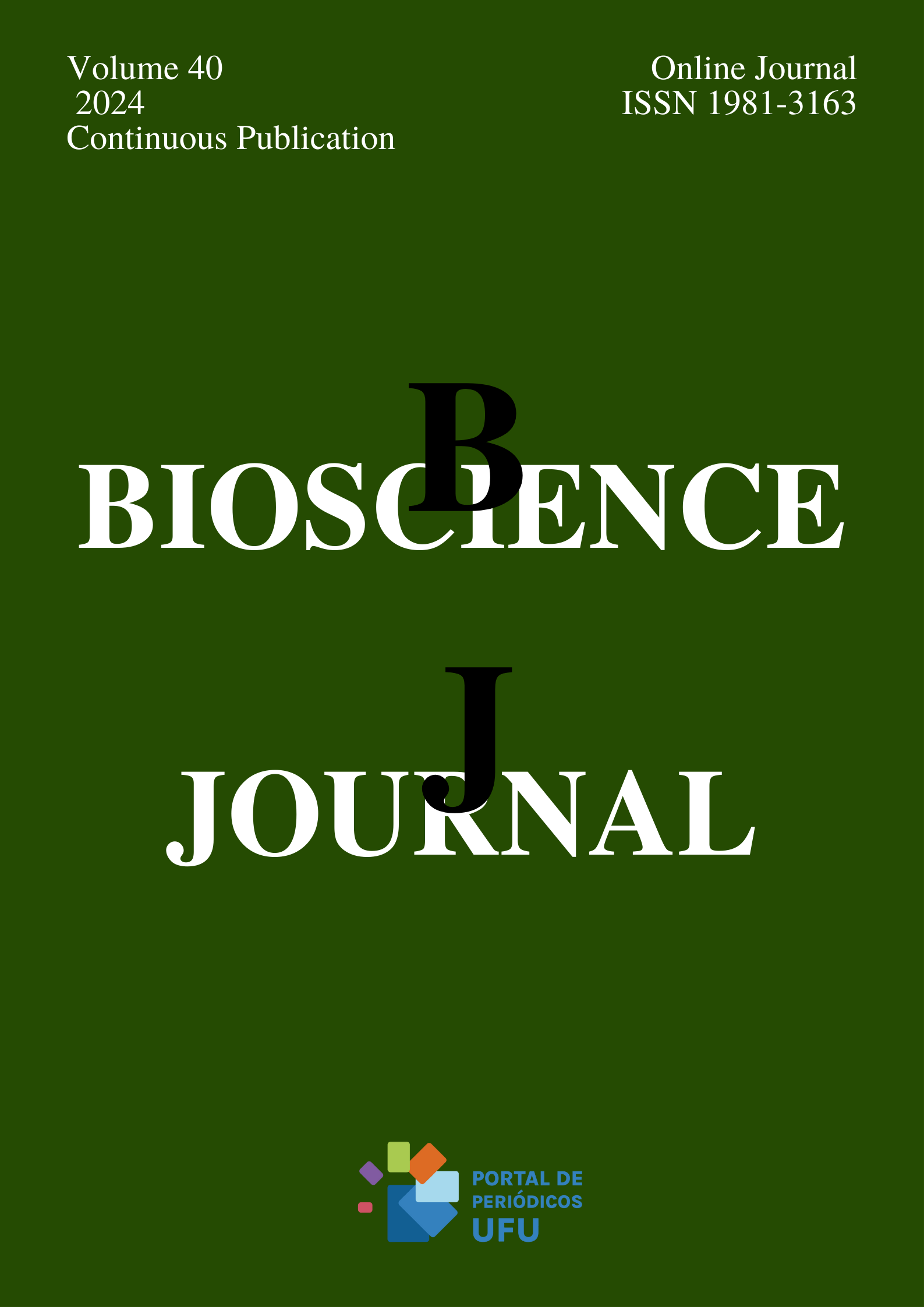A comprehensive study on nutrient content of raw and roasted nuts
DOI:
https://doi.org/10.14393/BJ-v40n0a2024-69160Keywords:
Minerals, Nutrition value, Nuts, Raw, Roast.Abstract
Nuts are highly valued for their properties and are consumed worldwide owing to their health benefits, particularly, for the prevention and treatment of diseases, as well as a source of essential macro- and micronutrients. This study aimed to evaluate the effects of roasting on the nutritional value of nuts. Three types of nuts, raw and roasted almonds, cashews, and walnuts were selected from three well-known companies in Saudi Arabia. To analyze and evaluate the stability of macro- and micronutrients in nuts, modern separation and quantification methods, including inductively coupled plasma-optical emission spectrometry (ICP-OSE), were used to analyze and evaluate the stability of nutrients and heavy metals in nuts that are widely distributed and consumed. The results of this study indicate that nuts have high nutritional value and an inverse roasting effect. Comparing the nutrient and metal contents of raw and roasted nuts provides useful information on the nutritional science of nuts consumed by well-known manufacturers in the Kingdom of Saudi Arabia. Further investigations of nuts are needed to draw firm conclusions regarding their association with the prevention of many different diseases.
Downloads
References
ALAMPRESE, C., RATTI, S. and ROSSI, M. Effects of Roasting Conditions on Hazelnut Characteristics in a Two-Step Process. Journal of Food Engineering. 2009, 95(2), 272–279. https://doi.org/10.1016/j.jfoodeng.2009.05.001
BAGHERI, H. Application of Infrared Heating for Roasting Nuts. Journal of Food Quality. 2020, 4, 1–10. https://doi.org/10.1155/2020/8813047
BAILEY, D. The Determination of Ascorbic Acid: A Quantitative Analysis Experiment. Journal of Chemical Education. 1974, 51(7), 488. https://doi.org/10.1021/ed051p488
BAILEY, H., and Stein, H. Raw and Roasted Pistachio Nuts (Pistacia Vera L.) Are ‘Good’Sources of Protein Based on Their Digestible Indispensable Amino Acid Score as Determined in Pigs. Journal of the Science of Food and Agriculture. 2020, 100(10), 3878–3885.
https://doi.org/10.1002/jsfa.10429
BERNSTEIN, M., ROIZEN, M.F. and MARTINEZ, L. Purified Palmitoleic Acid for the Reduction of High-Sensitivity C-Reactive Protein and Serum Lipids: A Double-Blinded, Randomized, Placebo Controlled Study. Journal of Clinical Lipidology. 2014, 8(6), 612–617.
https://doi.org/10.1016/j.jacl.2014.08.001
CHRISTOPOULOS, V. and TSANTILI, E. Oil Composition in Stored Walnut Cultivars—Quality and Nutritional Value. European Journal of Lipid Science and Technology. 2015, 117(3), 338–348. https://doi.org/10.1002/ejlt.201400082
CUNNIFF, P. Association of Official Analytical Chemists. Official Methods of AOAC Analysis. 1995, 1995. https://doi.org/10.1007/BF02670789
DODEVSKA, M., et al. Similarities and Differences in the Nutritional Composition of Nuts and Seeds in Serbia. Frontiers in Nutrition. 2022, 16(9), 1003125. https://doi.org/10.3389/fnut.2022.1003125
ESLAMI, O., et al. Effect of Nuts on Components of Metabolic Syndrome in Healthy Adults with Overweight/Obesity: A Systematic Review and Meta-Analysis. Nutrition, Metabolism and Cardiovascular Diseases. 2022, 32(11), 2459-2469. https://doi.org/10.1016/j.numecd.2022.07.015
FULTON, A., et al. Water-Indexed Benefits and Impacts of California Almonds. Journal of Ecological Indicators. 2018, 96(1), 711-717.
https://doi.org/10.1016/j.ecolind.2017.12.063
GORJI, N., et al. Almond, Hazelnut and Walnut, Three Nuts for Neuroprotection in Alzheimer’s Disease: A Neuropharmacological Review of Their Bioactive Constituents. Pharmacological Research. 2018, 129, 115–127. https://doi.org/10.1016/j.phrs.2017.12.003
GRIFFIN, L.E. and DEAN, L.L. Nutrient Composition of Raw, Dry-Roasted, and Skin-on Cashew Nuts. Journal of Food Research. 2017, 6(6), 13–28. https://doi.org/10.5539/jfr.v6n6p13
HAYES, M. Measuring Protein Content in Food: An Overview of Methods. Foods. 2020, 9(10), 1340. https://doi.org/10.3390/foods9101340
NIELSEN, S.S. Food Analysis Laboratory Manual. Springer. 2017, 3, 249. https://doi.org/10.1007/978-3-319-44127-6
OKONKWO, C.O. and OZOUDE, O.U. The Impact of Processing on the Nutrient Content, Vitamin and Mineral Composition of African Walnut (Tetracarpidium Conophorum). International Journal of Novel Research in Life Sciences. 2014, 1(2), 10–16.
OLABIYI, A.A., et al. Dietary Supplementation of Tiger Nut Alters Biochemical Parameters Relevant to Erectile Function in L-NAME Treated Rats. Food Research International. 2018, 109, 358–67. https://doi.org/10.1016/j.foodres.2018.04.046
PAPE, S.M., RUBIN, P.D. and KIM, H. Food Security Would Be Compromised by Combining the Food and Drug Administration and the US Department of Agriculture into a Single Food Agency. Food & Drug. 2004, 59, 405.
PRADHAN, C., NIKHILA, P. and DILEEP, N. Nuts as Dietary Source of Fatty Acids and Micro Nutrients in Human Health. Nuts and Nut Products in Human Health and Nutrition. 2021, 2021. http://dx.doi.org/10.5772/intechopen.94327
PRASAD, I.K. and BISHT, G. Evaluation of Nutritive, Antioxidant and Mineral Composition Of. Research Journal of Phytochemistry. 2011, 5(1), 54–59.
SRICHAMNONG, W. and SRZEDNICKI, G. Internal Discoloration of Various Varieties of Macadamia Nuts as Influenced by Enzymatic Browning and Maillard Reaction. Scientia Horticulturae. 2015, 192, 180–186. https://doi.org/10.1016/j.scienta.2015.06.012
SURESH, G., et al. Influence of Mineralogical and Heavy Metal Composition on Natural Radionuclide Concentrations in the River Sediments. Applied Radiation and Isotopes. 2011, 69(10), 1466–1474. https://doi.org/10.1016/j.apradiso.2011.05.020
TIAN, J., et al. Domestic Cooking Methods Affect the Phytochemical Composition and Antioxidant Activity of Purple-Fleshed Potatoes. Food Chemistry. 2016, 197, 1264–70. https://doi.org/10.1016/j.foodchem.2015.11.049
VENKATACHALAM, M. and SATHE, S.K. Chemical Composition of Selected Edible Nut Seeds. Journal of Agricultural and Food Chemistry. 2006, 54(13), 4705–14. https://doi.org/10.1021/jf0606959
WOJDYŁO, A., et al. Nuts as Functional Foods: Variation of Nutritional and Phytochemical Profiles and Their in Vitro Bioactive Properties. Food Chemistry. 2022, 15, 100418. https://doi.org/10.1016/j.fochx.2022.100418
YAACOUB, R., et al. Formation of Lipid Oxidation and Isomerization Products during Processing of Nuts and Sesame Seeds. Journal of Agricultural and Food Chemistry. 2008, 56(16), 7082–7090. https://doi.org/10.1021/jf800808d
ZONG, G., et al. Associations of Erythrocyte Palmitoleic Acid with Adipokines, Inflammatory Markers, and the Metabolic Syndrome in Middle-Aged and Older Chinese. The American Journal of Clinical Nutrition. 2012, 96(5), 970–976. https://doi.org/10.3945/ajcn.112.040204
Downloads
Published
How to Cite
Issue
Section
License
Copyright (c) 2024 Maryam H. Al-Zahrani, Lina A. Baz, Faiqa B. Sandokji, Mawada M. Barnawee, Maha J. Balgoon, Faeza A. Alazdi, Asmaa A. Alharbi

This work is licensed under a Creative Commons Attribution 4.0 International License.





